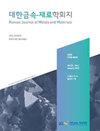Estimation of the Highest Thermoelectric Performance of the Bi-Doped SnTe at Room Temperature
IF 1.4
4区 材料科学
Q4 MATERIALS SCIENCE, MULTIDISCIPLINARY
引用次数: 0
Abstract
SnTe has drawn much attention due to its Pb-free composition along with tunable electronic and lattice structures. However, its intrinsically high defect concentration and high lattice thermal conductivity (κ1) have hindered its application in devices. Recently, Bi doping at Sn-sites in Sn1-xBixTe (x = 0.0 – 0.08) has been demonstrated to be effective in improving the thermoelectric performance (zT) of SnTe. Bi doping was particularly effective in improving the Seebeck coefficient in a wide range of temperature while suppressing its κ1. However, the effect of Bi doping on electronic band structure of SnTe has not been studied. Here, we applied the Single Parabolic Band (SPB) model to the room temperature electronic transport properties measurements (Seebeck coefficient, electrical conductivity, Hall carrier concentration) and analyzed how electronic band parameters like the density-of-states effective mass (md *), non-degenerate mobility (μ0), weighted mobility (μw), and B-factor changes with a changing Bi doping content (x). As the x increases, the md * increases while μ0 decreases. As the μw depends both on md * and μ0, it peaks at x = 0.02. Lastly, the B-factor is related to the ratio of μw to κ1, due to significantly decreasing κ1 at high x, the B-factor also becomes the highest at x = 0.08. Based on the B-factor of x = 0.08 sample, the highest theoretical zT of 0.31 is predicted using the SPB model. This is approximately 2.2 times higher than the experimental zT (~0.139) reported in literature at 300 K. The SPB model also guides us that the highest theoretical zT of 0.31 can be achieved if its Hall carrier concentration is tuned to 9.06 × 1018 cm-3.估算室温下双掺杂 SnTe 的最高热电性能
SnTe由于其无铅成分以及可调谐的电子和晶格结构而受到广泛关注。然而,其固有的高缺陷浓度和高晶格导热系数(κ1)阻碍了其在器件中的应用。近年来,在Sn1-xBixTe (x = 0.0 - 0.08)的sn位掺杂Bi已被证明可以有效地改善SnTe的热电性能(zT)。在较宽的温度范围内,铋掺杂能有效地提高塞贝克系数,同时抑制其κ1。然而,Bi掺杂对SnTe电子能带结构的影响尚未得到研究。本文将单抛物带(SPB)模型应用于室温电子输运特性的测量(塞贝克系数、电导率、霍尔载流子浓度),分析了态密度有效质量(md *)、非简并迁移率(μ0)、加权迁移率(μw)和b因子等电子带参数随Bi掺杂量(x)的变化规律。随着x的增加,md *增大,μ0减小。由于μw同时依赖于md *和μ0,所以在x = 0.02处达到峰值。最后,b因子与μw / κ1的比值有关,由于μw / κ1在x = 0.08时显著降低,b因子在x = 0.08时也达到最高。在b因子为x = 0.08的样本基础上,利用SPB模型预测了最高理论zT为0.31。这大约是文献报道的实验zT(~0.139)在300 K时的2.2倍。SPB模型还指导我们,当其霍尔载流子浓度调至9.06 × 1018 cm-3时,可以实现0.31的最高理论zT。
本文章由计算机程序翻译,如有差异,请以英文原文为准。
求助全文
约1分钟内获得全文
求助全文
来源期刊

Korean Journal of Metals and Materials
MATERIALS SCIENCE, MULTIDISCIPLINARY-METALLURGY & METALLURGICAL ENGINEERING
CiteScore
1.80
自引率
58.30%
发文量
100
审稿时长
4-8 weeks
期刊介绍:
The Korean Journal of Metals and Materials is a representative Korean-language journal of the Korean Institute of Metals and Materials (KIM); it publishes domestic and foreign academic papers related to metals and materials, in abroad range of fields from metals and materials to nano-materials, biomaterials, functional materials, energy materials, and new materials, and its official ISO designation is Korean J. Met. Mater.
 求助内容:
求助内容: 应助结果提醒方式:
应助结果提醒方式:


